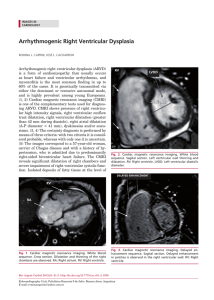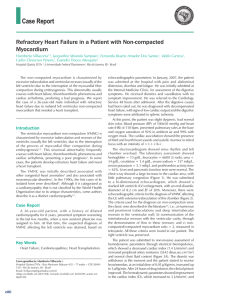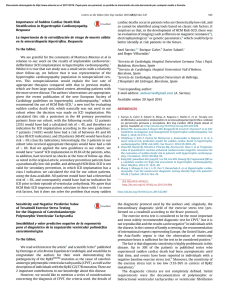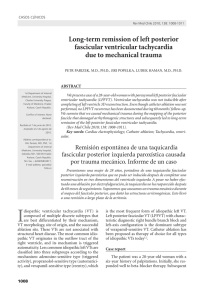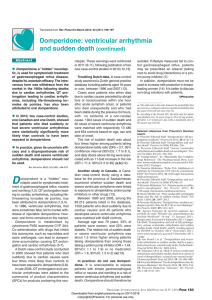Incidence and Predictors of Sudden Cardiac Arrest in Adults With
Anuncio
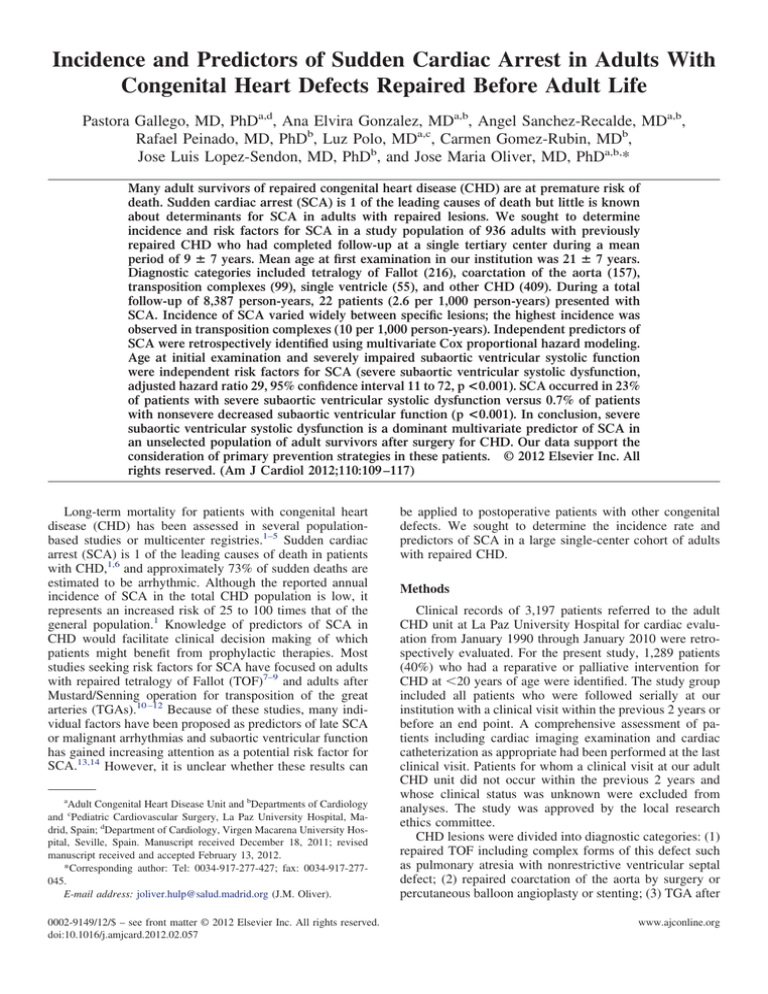
Incidence and Predictors of Sudden Cardiac Arrest in Adults With Congenital Heart Defects Repaired Before Adult Life Pastora Gallego, MD, PhDa,d, Ana Elvira Gonzalez, MDa,b, Angel Sanchez-Recalde, MDa,b, Rafael Peinado, MD, PhDb, Luz Polo, MDa,c, Carmen Gomez-Rubin, MDb, Jose Luis Lopez-Sendon, MD, PhDb, and Jose Maria Oliver, MD, PhDa,b,* Many adult survivors of repaired congenital heart disease (CHD) are at premature risk of death. Sudden cardiac arrest (SCA) is 1 of the leading causes of death but little is known about determinants for SCA in adults with repaired lesions. We sought to determine incidence and risk factors for SCA in a study population of 936 adults with previously repaired CHD who had completed follow-up at a single tertiary center during a mean period of 9 ⴞ 7 years. Mean age at first examination in our institution was 21 ⴞ 7 years. Diagnostic categories included tetralogy of Fallot (216), coarctation of the aorta (157), transposition complexes (99), single ventricle (55), and other CHD (409). During a total follow-up of 8,387 person-years, 22 patients (2.6 per 1,000 person-years) presented with SCA. Incidence of SCA varied widely between specific lesions; the highest incidence was observed in transposition complexes (10 per 1,000 person-years). Independent predictors of SCA were retrospectively identified using multivariate Cox proportional hazard modeling. Age at initial examination and severely impaired subaortic ventricular systolic function were independent risk factors for SCA (severe subaortic ventricular systolic dysfunction, adjusted hazard ratio 29, 95% confidence interval 11 to 72, p <0.001). SCA occurred in 23% of patients with severe subaortic ventricular systolic dysfunction versus 0.7% of patients with nonsevere decreased subaortic ventricular function (p <0.001). In conclusion, severe subaortic ventricular systolic dysfunction is a dominant multivariate predictor of SCA in an unselected population of adult survivors after surgery for CHD. Our data support the consideration of primary prevention strategies in these patients. © 2012 Elsevier Inc. All rights reserved. (Am J Cardiol 2012;110:109 –117) Long-term mortality for patients with congenital heart disease (CHD) has been assessed in several populationbased studies or multicenter registries.1–5 Sudden cardiac arrest (SCA) is 1 of the leading causes of death in patients with CHD,1,6 and approximately 73% of sudden deaths are estimated to be arrhythmic. Although the reported annual incidence of SCA in the total CHD population is low, it represents an increased risk of 25 to 100 times that of the general population.1 Knowledge of predictors of SCA in CHD would facilitate clinical decision making of which patients might benefit from prophylactic therapies. Most studies seeking risk factors for SCA have focused on adults with repaired tetralogy of Fallot (TOF)7–9 and adults after Mustard/Senning operation for transposition of the great arteries (TGAs).10 –12 Because of these studies, many individual factors have been proposed as predictors of late SCA or malignant arrhythmias and subaortic ventricular function has gained increasing attention as a potential risk factor for SCA.13,14 However, it is unclear whether these results can a Adult Congenital Heart Disease Unit and bDepartments of Cardiology and cPediatric Cardiovascular Surgery, La Paz University Hospital, Madrid, Spain; dDepartment of Cardiology, Virgen Macarena University Hospital, Seville, Spain. Manuscript received December 18, 2011; revised manuscript received and accepted February 13, 2012. *Corresponding author: Tel: 0034-917-277-427; fax: 0034-917-277045. E-mail address: joliver.hulp@salud.madrid.org (J.M. Oliver). 0002-9149/12/$ – see front matter © 2012 Elsevier Inc. All rights reserved. doi:10.1016/j.amjcard.2012.02.057 be applied to postoperative patients with other congenital defects. We sought to determine the incidence rate and predictors of SCA in a large single-center cohort of adults with repaired CHD. Methods Clinical records of 3,197 patients referred to the adult CHD unit at La Paz University Hospital for cardiac evaluation from January 1990 through January 2010 were retrospectively evaluated. For the present study, 1,289 patients (40%) who had a reparative or palliative intervention for CHD at ⬍20 years of age were identified. The study group included all patients who were followed serially at our institution with a clinical visit within the previous 2 years or before an end point. A comprehensive assessment of patients including cardiac imaging examination and cardiac catheterization as appropriate had been performed at the last clinical visit. Patients for whom a clinical visit at our adult CHD unit did not occur within the previous 2 years and whose clinical status was unknown were excluded from analyses. The study was approved by the local research ethics committee. CHD lesions were divided into diagnostic categories: (1) repaired TOF including complex forms of this defect such as pulmonary atresia with nonrestrictive ventricular septal defect; (2) repaired coarctation of the aorta by surgery or percutaneous balloon angioplasty or stenting; (3) TGA after www.ajconline.org 110 Table 1 Patient demographics, data on follow-up, and long-term outcomes in entire cohort and in each congenital heart disease category Diagnostic Category Men Age (years) Follow-Up (years) SCA Death or Transplantation Initial Examination (%) Last Follow-Up Mean ⫾ SD Person-Years Cases (%) Incidence/1,000 Person-Years Age at Sudden Arrest Cases (%) Incidence/1,000 Person-Years Age at End Point 216 (23%) 157 (17%) 89 (10%) 85 (9%) 85 (9%) 72 (8%) 112 (52%) 87 (55%) 56 (63%) 56 (66%) 47 (55%) 27 (37%) 22 ⫾ 9 19 ⫾ 7 19 ⫾ 4 19 ⫾ 6 22 ⫾ 8 19 ⫾ 5 32 ⫾ 8 28 ⫾ 9 28 ⫾ 6 30 ⫾ 8 30 ⫾ 9 27 ⫾ 7 10 ⫾ 7 9⫾6 9⫾6 11 ⫾ 8 8⫾7 8⫾6 2,127 1,406 838 971 719 560 3 (1%) 3 (2%) 8 (9%) 0 0 1 (1%) 1.4 2.1 9.5 0 0 1.8 40 ⫾ 17 35 ⫾ 29 26 ⫾ 10 — 20 ⫾ 0 20 ⫾ 0 10 (5%) 7 (4%) 10 (11%) 3 (4%) 2 (2%) 2 (3%) 4.7 5 12 3.1 2.8 3.6 31 ⫾ 11 28 ⫾ 18 26 ⫾ 9 30 ⫾ 4 30 ⫾ 4 23 ⫾ 4 68 (7%) 30 (44%) 20 ⫾ 5 28 ⫾ 8 8⫾6 554 2 (3%) 3.6 34 ⫾ 1 2 (3%) 3.6 34 ⫾ 1 57 (6%) 32 (3%) 20 (35%) 14 (44%) 21 ⫾ 7 18 ⫾ 3 26 ⫾ 8 29 ⫾ 6 5⫾5 11 ⫾ 6 287 357 0 1 (3%) 0 2.8 — 36 0 5 (16%) 0 14 — 25 ⫾ 9 23 (2%) 10 (44%) 26 ⫾ 9 34 ⫾ 8 8⫾9 185 1 (4%) 5.4 22 3 (13%) 16 32 ⫾ 11 21 (2%) 3 (14%) 28 ⫾ 14 36 ⫾ 13 8⫾7 159 0 0 — 0 0 — 10 (1%) 6 (60%) 24 ⫾ 9 32 ⫾ 9 8⫾7 79 2 (20%) 25 39 ⫾ 11 5 (50%) 63 31 ⫾ 9 21 (2%) 936 10 (48%) 478 (51%) 21 ⫾ 10 21 ⫾ 7 28 ⫾ 11 30 ⫾ 8 7⫾5 9⫾7 145 8,387 1 (5%) 22 (2.3%) 23 ⫾ 0 31 ⫾ 14 1 (5%) 50 (5.3%) 6.9 2.6 6.9 5.9 23 ⫾ 0 29 ⫾ 10 The American Journal of Cardiology (www.ajconline.org) Tetralogy of Fallot Aortic coarctation D-transposition Aortic stenosis Pulmonic stenosis Atrioventricular septal defect Ventricular septal defect Atrial septal defect Single ventricle (Fontan procedure) Single ventricle (shunt/Glenn) Patent ductus arteriosus Congenitally corrected transposition of great arteries Miscellaneous Overall Cases (%) Table 2 Variable distribution by diagnostic category in 936 patients with congenital heart disease repaired before 20 years of age Tetralogy of Fallot Aortic coarctation D-transposition Aortic stenosis Pulmonic stenosis Atrioventricular septal defect Ventricular septal defect Atrial septal defect Single ventricle (Fontan procedure) Single ventricle (shunt/Glenn) Patent ductus arteriosus Congenitally corrected transposition of great arteries Miscellaneous Overall NYHA Class ⬎II Endocarditis 32 (15%) 11 (7%) 11 (12%) 5 (6%) 9 (11%) 6 (8%) 8 (4%) 4 (3%) 2 (2%) 4 (5%) 0 1 (1%) 0 Subaortic Subpulmonary Subaortic Right Ventricle 52 (24%) 18 (11%) 12 (13%) 13 (15%) 13 (15%) 6 (8%) 7 (3%) 4 (3%) 28 (31%) 1 (1%) 0 3 (4%) 34 (16%) 2 (1%) 7 (8%) 0 8 (9%) 1 (1%) 0 0 74 (83%) 0 0 0 35 (16%) 8 (5%) 37 (42%) 4 (5%) 9 (11%) 10 (14%) 4 (6%) 3 (4%) 2 (3%) 0 0 1 (2%) 16 (50%) 0 0 1 (2%) 11 (34%) 0 6 (19%) 1 (2%) 0 14 (61%) 2 (9%) 8 (35%) 8 (35%) 1 (5%) 0 2 (10%) 4 (40%) 0 2 (10%) 111 (12%) 0 25 (2.7%) Reoperation SVSD Clinical Sustained Arrhythmia Severe Pulmonary Hypertension SVR Pulmonary Subpulmonary AV Valve Subaortic AV Valve Aorta 6 (3%) 10 (6%) 2 (2%) 1 (1%) 2 (2%) 5 (7%) 109 (50%) 1 (1%) 2 (2%) 0 25 (29%) 1 (1%) 25 (12%) 1 (1%) 4 (4%) 1 (1%) 8 (9%) 3 (4%) 2 (1%) 5 (3%) 12 (13%) 2 (2%) 1 (1%) 18 (25%) 11 (5%) 9 (6%) 4 (4%) 23 (27%) 1 (1%) 4 (6%) 5 (7%) 1 (1%) 0 1 (1%) 1 (1%) 5 (7%) 0 3 (9%) 3 (5%) 17 (53%) 0 0 0 0 0 0 1 (2%) 4 (12%) 0 0 8 (35%) 4 (17%) 15 (65%) 6 (26%) 2 (9%) 3 (13%) 2 (12%) 0 2 (10%) 0 0 1 (5%) 1 (5%) 0 0 0 1 (5%) 3 (30%) 7 (70%) 0 10 (100%) 7 (70%) 1 (10%) 0 2 (20%) 5 (50%) 1 (10%) 3 (14%) 144 (15%) 1 (5%) 69 (7.4%) 1 (5%) 62 (6.6%) 0 91 (10%) 7 (33%) 158 (17%) 1 (1%) 35 (3.7%) 2 (10%) 142 (15%) 3 (14%) 51 (5.4%) 3 (14%) 55 (5.9%) 0 59 (6.3%) Congenital Heart Disease/Sudden Death in Adult Congenital Heart Disease Diagnostic Category AV ⫽ atrioventricular; NYHA ⫽ New York Heart Association; SVR ⫽ severe valve regurgitation; SVSD ⫽ severe ventricular systolic dysfunction. 111 112 The American Journal of Cardiology (www.ajconline.org) Figure 2. Incidence of all-cause of death or transplantation (A) and sudden cardiac arrest (B) for each diagnostic category. Data are presented as number of events per 1,000 person-years. CA ⫽ coarctation of aorta; SV ⫽ single-ventricle physiology. Figure 1. Cause of death in 50 deceased patients by lesion (percentages): perioperative death or death within 30 days after cardiac surgery; heart failure or death from progressive symptoms of fluid congestion or decreased cardiac output; other cardiovascular (CV) deaths included aortic rupture, endocarditis, acute myocardial infarction, pulmonary embolism, or stroke. Senning, Mustard, Rastelli, and/or Jatene procedures; (4) surgical or percutaneous relief of valvular, discrete subvalvar, and supravalvar aortic stenosis; (5) repaired obstructive right ventricular outflow tract lesions after surgical or balloon valvulotomy or patch reconstruction; (6) surgically repaired atrioventricular septal defect (including primum atrial septal defect); (7) surgically repaired ventricular septal defect; (8) repaired ostium secundum or sinus venosus defect; (9) anatomic or functional single-ventricle physiology after Fontan palliation; (10) single-ventricle physiology after aortopulmonary shunts or Glenn shunt palliation; (11) patent ductus arteriosus repaired by surgery or catheterization; and (12) congenitally corrected TGA after surgical repair of a ventricular septal defect, left ventricular outflow tract obstructive lesions, or left atrioventricular valve dysfunction. Diagnoses that did not belong in 1 of these 12 diagnostic categories such as total pulmonary venous anomalous connection or coronary anomalies were categorized as miscellaneous. If ⬎1 diagnostic category applied, the hemodynamically most important lesion for each patient regarding long-term outcome was classified as the principal diagnosis. If ⬎1 lesion was considered to have a major impact on morbidity, the driver to assign the principal di- agnosis was the lesion considered the indication for the initial surgical approach. Details of demographic characteristics, clinical status, Doppler echocardiography, cardiac magnetic resonance imaging, and cardiac catheterization were abstracted from patients’ clinical records. The most recent data preceding the end points were requested. Evaluation of systolic ventricular function was based on M-mode and 2-dimensional echocardiographic measurements and expert visual assessment supplemented by objective measurements including ventricular diameters, fractional shortening, tricuspid or mitral annular plane systolic excursion, and tissue Doppler parameters. Because ventricular function in the morphologic right ventricle and for single-ventricle physiology may be assessed inaccurately by echocardiography, for the previous 10 years those patients with significantly decreased subaortic or subpulmonary right ventricular systolic function underwent cardiac magnetic resonance whenever possible to confirm the severity of ventricular dysfunction. Subaortic and subpulmonary systolic ventricular functions were visually graded by echocardiography in 4 degrees: (1) normal (ejection fraction ⱖ55%), (2) borderline to mild (ejection fraction 45% to 54%), (3) moderate (ejection fraction 35% to 44%), and (4) severe (ejection fraction ⬍35%) dysfunction. Consistent with recently modified recommendations for implantable cardioverter– defibrillator (ICD) implantation in heart failure,15 an ejection fraction ⬍35% was used in this study to define severe impairment. For univariate and multivariate models, the following variables were assessed: (1) gender; (2) age at first examination in our adult CHD clinic; (3) age at last examination Congenital Heart Disease/Sudden Death in Adult Congenital Heart Disease 113 Table 3 Proportional distribution of variables and diagnostic categories according to outcomes (sudden cardiac arrest, death or heart transplantation, or survivors free of transplantation) Variables SCA (n ⫽ 22) All-Cause Death or Transplantation (n ⫽ 50) Survival Free of Transplantation (n ⫽ 886) Age at first examination (years) Men New York Heart Association class ⬎II (%) Left ventricular outflow tract obstruction Tetralogy of Fallot Systemic-to-pulmonary shunt Transposition of great arteries Single-ventricle physiology Severe subaortic ventricular systolic dysfunction Severe subpulmonary ventricular systolic dysfunction Morphologic subaortic right ventricle Clinical sustained arrhythmias Severe pulmonary hypertension Severe pulmonary valve regurgitation Severe subpulmonary atrioventricular valve regurgitation Severe subaortic atrioventricular valve regurgitation Severe aortic valve regurgitation Infective endocarditis Need for reintervention 24 ⫾ 14 15 (68%) 7 (32%)† 3 (14%) 3 (14%) 3 (14%) 10 (45%)* 2 (9%) 16 (73%)* 5 (23%)† 9 (41%)* 14 (64%)* 3 (14%)† 3 (14%) 2 (9%) 3 (14%) 0 0 5 (23%) 22 ⫾ 9 28 (56%) 27 (54%)* 10 (20%) 10 (20%) 4 (8%)† 15 (30%)* 8 (16%)† 28 (56%)* 12 (24%)* 14 (28%)* 23 (46%)* 10 (20%)* 8 (16%) 3 (6%) 9 (18%)* 4 (8%) 2 (4%) 21 (42%)* 21 ⫾ 7 450 (51%) 84 (9%) 232 (26%) 206 (23%) 214 (24%) 84 (9%) 47 (5%) 41 (5%) 50 (6%) 77 (9%) 135 (15%) 25 (3%) 134 (15%) 48 (5%) 47 (5%) 55 (6%) 23 (3%) 123 (14%) * p ⬍0.001; † p ⬍0.01 compared to survival free of transplantation. or at end-point event; (4) time from first visit to any end point or to last visit; (5) New York Heart Association functional classes I to II or ⬎II at the last examination; (6) clinically sustained arrhythmias such as supraventricular or ventricular tachycardia, atrioventricular block, or sinus node disease that required pacemaker implantation (nonsustained arrhythmias captured from Holter monitoring or data on ambient ectopy were not considered in analysis); (7) infective endocarditis during adult follow-up; (8) need for surgical or percutaneous reintervention during follow-up; (9) severely impaired systolic function of the subaortic ventricle at last cardiac imaging study; (10) severely impaired subpulmonary ventricular function at last cardiac imaging study; (11) subaortic right ventricle (single or biventricular physiology); (12) severe pulmonary hypertension defined as a pulmonary-to-systemic systolic pressure ratio ⬎50% on cardiac catheterization or Doppler evaluation; (13) severe pulmonary regurgitation assessed by echocardiography or cardiac magnetic resonance; (14) severe aortic regurgitation assessed by echocardiography or cardiac magnetic resonance; (15) severe subaortic atrioventricular valve regurgitation assessed qualitatively by Doppler echocardiography; and (16) severe subpulmonary atrioventricular valve regurgitation assessed qualitatively by Doppler echocardiography. Diagnostic categories were also entered into the models. According to previous publications,2,4 cause of death was classified as sudden death, death secondary to heart failure, perioperative death, other cardiovascular death, or noncardiovascular death. Other causes of cardiovascular death included aortic rupture, endocarditis, acute myocardial infarction, pulmonary embolism, and stroke. The primary end point was SCA defined as the combined end point of sudden death or aborted cardiac arrest. Sudden death was defined as death within 1 hour of symptom onset and proved or believed to be arrhythmic in nature. Aborted cardiac arrest included successful cardiopulmonary resuscitation of a cardiovascular collapse resulting from ventricular fibrillation and documented appropriate ICD discharge delivered in response to polymorphic ventricular tachycardia or ventricular fibrillation. A secondary composite end point included all-cause of death and heart or heart–lung transplantation. SPSS 15.0 for Windows (SPSS, Inc., Chicago, Illinois) was used for statistical analyses. Quantitative values are summarized as mean ⫾ SD. Categorical variables are presented as percentage. For purposes of the analyses, age and time computed since the first visit at our clinic were considered continuous variables and all other variables were considered categorical. Patients fulfilling inclusion criteria were retrospectively included in the analysis at the time of their first visit at the adult CHD clinic during the study period. Person-years were accrued from time of entry until an end point or until the last follow-up visit before study termination. Prevalence was presented as percentage and defined as total number of events that occurred during total follow-up period divided by total number of cases or by number of patients in each diagnostic category. Incidence was measured by relating the number of new events to person-years at risk and calculated by summing the periods during which patients in the total population or in each diagnostic category were at risk during the observation period. It was represented by events per 1,000 person-years. Comparison of variables between groups was performed with Mann–Whitney U test. To assess predictors for SCA in longitudinal analysis, univariate analyses of individual variables were performed using Cox proportional hazards models from which hazard ratios and 95% confidence intervals were generated. To determine independent risk factors, variables with a p value ⬍0.2 in univariate analysis were en- 114 The American Journal of Cardiology (www.ajconline.org) Table 4 Univariate and multivariate Cox proportional models for survival free from sudden cardiac arrest Analysis Univariate Multivariate Variable HR 95% CI p Value age at first examination gender New York Heart Association class ⬎II left ventricular outflow tract obstruction tetralogy of Fallot systemic-to-pulmonary shunt transposition single-ventricle physiology severe subaortic ventricular systolic dysfunction severe subpulmonary ventricular systolic dysfunction morphologic subaortic right ventricle clinical sustained arrhythmias severe pulmonary hypertension severe pulmonary valve regurgitation severe subpulmonary atrioventricular valve regurgitation severe subaortic atrioventricular valve regurgitation severe aortic valve regurgitation infective endocarditis need for reintervention severe subaortic ventricular systolic dysfunction age at first examination 1.07 0.5 2.9 0.4 0.5 0.7 6.8 1.4 33 3.9 5.9 7.6 3.9 0.8 1.7 2.5 0.4 0.0 1,3 29 1.05 1.0–1.1 0.2–1.2 1.2–7.2 0.1–1.3 0.1–1.6 0.2–2.3 2.9–16 0.3–6.2 13–84 1.4–10 2.5–14 3.2–18 1.2–13 0.2–2.7 0.4–7.3 0.8–8.6 0–32 0.0 0.5–3.5 11–76 1.0–1.1 ⬍0.001 0.14 0.02 0.14 0.22 0.55 ⬍0.001 0.62 ⬍0.001 0.008 ⬍0.001 ⬍0.001 0.03 0.70 0.48 0.13 0.35 0.57 0.60 ⬍0.001 0.019 CI ⫽ confidence interval; HR ⫽ hazard ratio. tered into the multivariate Cox proportional model (forward stepwise, p ⫽ 0.05 for entry and p ⫽ 0.1 for removal). Two-tailed p values ⬍0.05 were considered statistically significant. Results In total 936 patients (73%) were eligible for inclusion and comprised the study population. Distribution of diagnostic categories and duration of follow-up for the entire sample and separately by CHD category are presented in Table 1. Although the mean follow-up period ranged from 5 ⫾ 5 years in patients with atrial septal defects to 11 ⫾ 8 years in patients with repaired aortic stenosis, differences in follow-up were not statistically significant between diagnostic categories. Further details on patient characteristics are presented in Table 2. It should be noted that 83% of patients with TGA repaired by a Mustard/Senning procedure plus 10 patients with congenitally corrected TGA and 7 of 55 patients with a single ventricle had morphologic right ventricles supporting their systemic circulation. During a total follow-up period of 20 years (8,387 person-years) 50 patients died or underwent transplantation. SCA occurred in 22 patients: 15 patients developed sudden death and 5 patients were successfully resuscitated after SCA and subsequently received an ICD for secondary prevention. In addition, 11 patients underwent ICD implantation for primary prevention (7 patients) or secondary prevention (4 patients). Of these 11 patients, appropriate ICD shocks for ventricular fibrillation were recorded in 2 patients; consistent with our definition of the primary end point, these patients were included in the SCA subgroup. Thus, prevalence and incidence of SCA in the entire sample of repaired CHD were 2.4% and 2.6 per 1,000 person-years, respectively. Figure 3. Multivariate Cox proportional model comparing actuarial freedom from sudden cardiac arrest in patients with severe systemic ventricular dysfunction (SSVD) versus patients with nonsevere subaortic ventricular dysfunction (non-SSVD). In another 22 patients, nonsudden cardiac death occurred from perioperative death (9 patients), heart failure (8 patients), and other cardiovascular causes (5 patients). Nnoncardiovascular death occurred in 2 patients and 4 patients underwent a heart or heart–lung transplantation at followup. After excluding aborted sudden death and transplantation, overall mortality was 4.2%, incidence of death was 4.7 per 1,000 person-years, and primary cause of death was SCA (38%) followed by reoperation (23%), heart failure (21%), and other cardiovascular causes (13%). Causes of death by lesions are shown in Figure 1. Congenital Heart Disease/Sudden Death in Adult Congenital Heart Disease Table 5 Comparative data on mortality between patients with and those without severe subaortic ventricular systolic dysfunction Cause of Death Sudden cardiac arrest Incidence/1,000 person-years Total death or transplantation Incidence/1,000 person-years Sudden cardiac arrest/total death ratio SSVSD Yes (n ⫽ 69) No (n ⫽ 867) 16 (23%) 26 28 (41%) 45 57% 6 (0.7%) 0.8 22 (2.5%) 2.8 27% p Value ⬍0.001 ⬍0.001 ⬍0.001 ⬍0.001 0.047 SSVSD ⫽ severe subaortic ventricular systolic dysfunction. Figure 2 illustrates the incidence of the composite end point of all-cause death or transplantation and of SCA by diagnostic category. Prevalence and incidence varied widely by the specific lesion (Table 1). The highest prevalence of SCA was observed in TGA complexes: 10 of 99 patients (10%) presented with SCA at follow-up, resulting in an incidence of SCA in combined TGA and congenitally corrected TGA of 10 per 1,000 person-years (Figure 2). Table 3 presents the proportional distribution of proposed risk factors according to outcomes in the entire cohort. Univariate and multivariate predictors of SCA are listed in Table 4. Independent factors associated with SCA among the proposed variables were age at first examination and severe subaortic ventricular systolic dysfunction (adjusted hazard ratio 29, 95% confidence interval 11 to 72; Figure 3). Comparative data on mortality in patients with severe versus nonsevere subaortic ventricular systolic dysfunction are presented in Table 5. Interestingly, annual risks of SCA in patients with severely impaired subaortic ventricular systolic function were 2.6% per year in the total CHD population, 3.0% per year for patients with subaortic right ventricular systolic dysfunction, and 3.1% per year for patients with TGA and severely decreased subaortic ventricular systolic function. Discussion To our knowledge, this is the first longitudinal cohort study to analyze predictors of SCA in a large population of adult survivors after operation for CHD at ⬍20 years of age. Results indicated that severe systemic ventricular dysfunction has an outstanding role as a dominant multivariate predictor of SCA for all combined diagnoses in this heterogenous population. Until recently, limited data existed on risk factors for SCA during long-term follow-up after surgery in the total adult CHD population. Despite a multitude of predictors of ventricular arrhythmia and/or SCA in studies that focused on patients with TOF8,9 and those who had undergone atrial switch procedures for TGA,10 –12 their predictive values are relatively low. Observational and registry studies in TGA with Mustard/Senning repair,10 –13 congenitally corrected TGA,16 left heart obstructive lesions,17,18 and TOF14,19,20 have provided some support for considering advanced sub- 115 aortic systolic ventricular dysfunction as a risk factor for SCA in patients with CHD. Although left ventricular systolic dysfunction is considered a powerful prognostic factor and an indication for ICD therapy in adults with ischemic or dilated cardiomyopathy,21,22 this statement requires elucidation in patients with CHD. Although the retrospective study design prevented the inclusion of other potential risk factors, in our series severely impaired subaortic (left, right, or single) systolic ventricular function was a multivariate determinant for SCA among the proposed predictors. In our study, risk for late SCA varied widely between lesions. Almost 80% of cases occurred in patients with TGA, single-ventricle physiology, coarctation of aorta, or TOF. Interestingly, there appeared to be a relation between the incidence of SCA and the development of subaortic ventricular systolic dysfunction between different lesions. The highest incidence was found in patients with transposition complexes, most of which had been repaired using Mustard/Senning procedures that result in a subaortic morphologic right ventricle. The long-term prognosis of patients after atrial switch procedures is a topic of concern and a late decrease of systemic right ventricular function is a well-recognized outcome in TGA after Mustard/Senning procedures and congenitally corrected TGA.10 –12,16 The total mortality of our population with single-ventricle physiology including patients after Fontan surgery and cyanotic patients with or without pulmonary hypertension palliated with surgical shunts was also high. However, there was a relatively smaller proportion of SCA deaths in patients with a single ventricle. Despite the high incidence of arrhythmias and advanced functional capacity impairment, the primary causes of death were heart failure and perioperative mortality. Although our patients with a single ventricle had developed some degree of ventricular dysfunction, severely impaired ventricular systolic function was relatively uncommon, which is consistent with previously reported data on the prevalence of ventricular dysfunction in this population.23,24 In accordance with previously published studies,1,2 we observed the third highest incidence of SCA in patients with repaired coarctation of the aorta. Left ventricular systolic function impairment without clinical evidence of coronary artery disease was also the primary risk factor for SCA in those studies. Finally, a strong association between left ventricular dysfunction and sudden death late after repair of the TOF has recently been reported.19,20,25 Because left ventricular dysfunction is rather less common than right ventricular function impairment in repaired TOF,26 this might explain the relatively low incidence of SCA of our study. There is controversy as to whether patients with CHD and severe subaortic ventricular systolic dysfunction should undergo prophylactic ICD implantation.27,28 To date, the clinical decision-making process for risk stratification in primary prevention of SCA integrates a multitude of predictors, but no risk factor had been individually demonstrated to possess high discriminative power to prompt ICD consideration. The present study provides evidence that advanced subaortic ventricular systolic dysfunction has an outstanding role as an independent risk factor for SCA in the postoperative adult CHD population seeking care at an 116 The American Journal of Cardiology (www.ajconline.org) adult clinic. Based on results of multicenter and major randomized clinical trials, Khairy29 provided a probabilistic approach to risk stratification in patients with TOF. Of studies that reported a mortality decrease, the benefit of ICD has been demonstrated if the baseline population risk for SCA is ⬎3.5% per year. The findings in our study on the annual risk of SCA for the total population and for patients with TGA or for patients with subaortic morphologic right ventricle indicate that subaortic ventricular systolic dysfunction may be a more important predictor for SCA than ventricular structure or type of lesion. Therefore, severe subaortic ventricular dysfunction could be ideally suited for initial risk stratification in our CHD population. This study has limitations inherent to any retrospective cohort study including the fact that only 73% patients had complete follow-up. Because most excluded patients had been examined at the adult CHD unit ⱖ1 time and presented with simple CHD, this bias likely does not have a major impact on risk factor analysis. Evaluation of ventricular function by echocardiography also poses a challenge for risk stratification in our retrospective study. Unfortunately, most episodes of SCA occurred during the first decade of follow-up when cardiac magnetic resonance was not fully available at our institution. However, when possible, reference was made to cardiac magnetic resonance estimates of ventricular function, which provides a more accurate assessment of morphologically right or single ventricular function. The definition of SCA might be controversial,30 but aborted sudden death was also considered a primary end point for providing data on the actual incidence of SCA. 1. Silka MJ, Hardy BG, Menashe VD, Morris CD. A population-based prospective evaluation of risk of sudden cardiac death after operation for common congenital heart defects. J Am Coll Cardiol 1998;32:245– 251. 2. Oechslin EN, Harrison DA, Connelly MS, Webb GD, Siu SC. Mode of death in adults with congenital heart disease. Am J Cardiol 2000;86: 1111–1116. 3. Engelfriet P, Boersma E, Oechslin E, Tijssen J, Gatzoulis MA, Thilén U, Kaemmerer H, Moons P, Meijboom F, Popelová J, Laforest V, Hirsch R, Daliento L, Thaulow E, Mulder B. The spectrum of adult congenital heart disease in Europe: morbidity and mortality in a 5 year follow-up period. The Euro Heart Survey on adult congenital heart disease. Eur Heart J 2005;26:2325–2333. 4. Nieminen HP, Jokinen EV, Sairanen HI. Causes of late deaths after pediatric cardiac surgery: a population-based study. J Am Coll Cardiol 2007;50:1263–1271. 5. Verheugt CL, Uiterwaal CS, van der Velde ET, Meijboom FJ, Pieper PG, van Dijk AP, Vliegen HW, Grobbee DE, Mulder BJ. Mortality in adult congenital heart disease. Eur Heart J 2010;31:1220 –1229. 6. Harrison DA, Connelly M, Harris L, Luk C, Webb GD, McLaughlin PR. Sudden cardiac death in the adult with congenital heart disease. Can J Cardiol 1996;12:1161–1163. 7. Gatzoulis MA, Till JA, Somerville J, Redington AN. Mechanoelectrical interaction in tetralogy of Fallot. QRS prolongation relates to right ventricular size and predicts malignant ventricular arrhythmias and sudden death. Circulation 1995;92:231–237. 8. Gatzoulis MA, Balaji S, Webber SA, Siu SC, Hokanson JS, Poile C, Rosenthal M, Nakazawa M, Moller JH, Gillette PC, Webb GD, Redington AN. Risk factors for arrhythmia and sudden cardiac death late after repair of tetralogy of Fallot: a multicentre study. Lancet 2000; 356:975–981. 9. Nollert GD, Däbritz SH, Schmoeckel M, Vicol C, Reichart B. Risk factors for sudden death after repair of tetralogy of Fallot. Ann Thorac Surg 2003;76:1901–1905. 10. Gelatt M, Hamilton RM, McCrindle BW, Connelly M, Davis A, Harris L, Gow RM, Williams WG, Trusler GA, Freedom RM. Arrhythmia 11. 12. 13. 14. 15. 16. 17. 18. 19. 20. 21. 22. 23. 24. 25. and mortality after the Mustard procedure: a 30-year single-center experience. J Am Coll Cardiol 1997;29:194 –201. Kammeraad JA, van Deurzen CH, Sreeram N, Bink-Boelkens MT, Ottenkamp J, Helbing WA, Lam J, Sobotka-Plojhar MA, Daniels O, Balaji S. Predictors of sudden cardiac death after Mustard or Senning repair for transposition of the great arteries. J Am Coll Cardiol 2004; 44:1095–1102. Schwerzmann M, Salehian O, Harris L, Siu SC, Williams WG, Webb GD, Colman JM, Redington A, Silversides CK. Ventricular arrhythmias and sudden death in adults after a Mustard operation for transposition of the great arteries. Eur Heart J 2009;30:1873– 1879. Gatzoulis MA, Walters J, McLaughlin PR, Merchant N, Webb GD, Liu P. Late arrhythmia in adults with the Mustard procedure for transposition of great arteries: a surrogate marker for right ventricular dysfunction? Heart 2000;84:409 – 415. Ghai A, Silversides C, Harris L, Webb GD, Siu SC, Therrien J. Left ventricular dysfunction is a risk factor for sudden cardiac death in adults with repaired tetralogy of Fallot. J Am Coll Cardiol 2002;40: 675– 680. Jessup M, Abraham WT, Casey DE, Feldman AM, Francis GS, Ganiats TG, Konstam MA, Mancini DM, Rahko PS, Silver MA, Stevenson LW, Yancy CW. 2009 Focused update: ACCF/AHA guidelines for the diagnosis and management of heart failure in adults: a report of the American College of Cardiology Foundation/American Heart Association Task Force on Practice Guidelines: developed in collaboration with the International Society for Heart and Lung Transplantation. Circulation 2009;119:1977–2016. Connelly MS, Liu PP, Williams WG, Webb GD, Robertson P, McLaughlin PR. Congenitally corrected transposition of the great arteries in the adult: functional status and complications. J Am Coll Cardiol 1996;27:1238 –1243. Toro-Salazar OH, Steinberger J, Thomas W, Rocchini AP, Carpenter B, Moller JH. Long-term follow-up of patients after coarctation of the aorta repair. Am J Cardiol 2002;89:541–547. Keane JF, Driscoll DJ, Gersony WM, Hayes CJ, Kidd L, O’Fallon WM, Pieroni DR, Wolfe RR, Weidman WH. Second natural history study of congenital heart defects. Results of treatment of patients with aortic valvar stenosis. Circulation 1993;87(suppl):I16 –I27. Khairy P, Aboulhosn J, Gurvitz MZ, Opotowsky AR, Mongeon FP, Kay J, Valente AM, Earing MG, Lui G, Gersony DR, Cook S, Ting G, Nickolaus MJ, Webb G, Landzberg MJ, Broberg CS; Alliance for Adult Research in Congenital Cardiology (AARCC). Arrhythmia burden in adults with surgically repaired tetralogy of Fallot: a multiinstitutional study. Circulation 2010;122:868 – 875. Yap SC, Roos-Hesselink JW, Hoendermis ES, Budts W, Vliegen HW, Mulder BJ, van Dijk AP, Schalij MJ, Drenthen W. Outcome of implantable cardioverter defibrillators in adults with congenital heart disease: a multi-centre study. Eur Heart J 2007;28:1854 –1861. Moss AJ, Zareba W, Hall WJ, Klein H, Wilber DJ, Cannom DS, Daubert JP, Higgins SL, Brown MW, Andrews ML; Multicenter Automatic Defibrillator Implantation Trial II Investigators. Prophylactic implantation of a defibrillator in patients with myocardial infarction and reduced ejection fraction. N Engl J Med 2002;346: 877– 883. Bardy GH, Lee KL, Mark DB, Poole JE, Packer DL, Boineau R, Domanski M, Troutman C, Anderson J, Johnson G, McNulty SE, Clapp-Channing N, Davidson-Ray LD, Fraulo ES, Fishbein DP, Luceri RM, Ip JH; Sudden Cardiac Death in Heart Failure Trial (SCD-HeFT) Investigators. Amiodarone or an implantable cardioverter-defibrillator for congestive heart failure. N Engl J Med 2005; 352:225–237. Khairy P, Fernandes SM, Mayer JE Jr, Triedman JK, Walsh EP, Lock JE, Landzberg MJ. Long-term survival, modes of death, and predictors of mortality in patients with Fontan surgery. Circulation 2008;117: 85–92. Norozi K, Wessel A, Alpers V, Arnhold JO, Geyer S, Zoege M, Buchhorn R. Incidence and risk distribution of heart failure in adolescents and adults with congenital heart disease after cardiac surgery. Am J Cardiol 2006;97:1238 –1243. Khairy P, Harris L, Landzberg MJ, Viswanathan S, Barlow A, Gatzoulis MA, Fernandes SM, Beauchesne L, Therrien J, Chetaille P, Gordon E, Vonder Muhll I, Cecchin F. Implantable cardioverterdefibrillators in tetralogy of Fallot. Circulation 2008;117:363–370. Congenital Heart Disease/Sudden Death in Adult Congenital Heart Disease 26. Broberg CS, Aboulhosn J, Mongeon FP, Kay J, Valente AM, Khairy P, Earing MG, Opotowsky AR, Lui G, Gersony DR, Cook S, Ting JG, Webb G, Gurvitz MZ; Alliance for Adult Research in Congenital Cardiology (AARCC). Prevalence of left ventricular systolic dysfunction in adults with repaired tetralogy of Fallot. Am J Cardiol 2011; 107:1215–1220. 27. Silka MJ, Bar-Cohen Y. Should patients with congenital heart disease and a systemic ventricular ejection fraction less than 30% undergo prophylactic implantation of an ICD? Patients with congenital heart disease and a systemic ventricular ejection fraction less than 30% should undergo prophylactic implantation of an implantable cardioverter defibrillator. Circ Arrhythm Electrophysiol 2008;1:298 –306. 28. Triedman JK. Should patients with congenital heart disease and a systemic ventricular ejection fraction less than 30% undergo prophy- 117 lactic implantation of an ICD? Implantable cardioverter defibrillator implantation guidelines based solely on left ventricular ejection fraction do not apply to adults with congenital heart disease. Circ Arrhythm Electrophysiol 2008;1:307–316. 29. Khairy P. Programmed ventricular stimulation for risk stratification in patients with tetralogy of Fallot. A bayesian perspective. Nat Clin Practice Cardiovasc Med 2007;4:292–293. 30. Ellenbogen KA, Levine JH, Berger RD, Daubert JP, Winters SL, Greenstein E, Shalaby A, Schaechter A, Subacius H, Kadish A; Defibrillators in Non-Ischemic Cardiomyopathy Treatment Evaluation (DEFINITE) Investigators. Are implantable cardioverter defibrillator shocks a surrogate for sudden cardiac death in patients with nonischemic cardiomyopathy? Circulation 2006;113:776 – 782.
